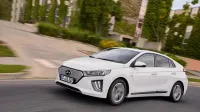Hyundai Ioniq will exit production in July 2022 without a successor

Hyundai announced that the Ioniq, a hatchback designed to counter cars like the Toyota Prius and Chevy Volt, will retire in July 2022 after a six-year production run. The model will not be directly replaced, but it made a lasting impact on the South Korean firm’s lineup.
Launched for 2017, the Ioniq was developed to offer three different powertrain types from the get-go: It was available as a hybrid, a plug-in hybrid, and an EV. Hyundai designed it for maximum efficiency, its designers notably achieved a 0.24 drag coefficient, and the Ioniq even spawned an autonomous prototype that was tested on the streets of Las Vegas and displayed at the 2017 Geneva auto show.
Fuel economy was one of the Ioniq’s main selling points. The plug-in hybrid model was rated at 119 mpg-e, according to the Environmental Protection Agency (EPA), and it offered up to 620 miles of driving range. And the ultra-efficient Blue hybrid was rated at 59 mpg combined with a 702-mile range.
Speaking of range, that was never the EV’s strongest assets: Its 28-kilowatt-hour battery pack was initially rated at merely 124 miles, which Hyundai admitted was “not enough.” That figure increased to 170 for the 2020 model year thanks in part to a bigger, 38.3-kilowatt-hour battery pack.
Hyundai said that its European dealers stopped taking orders for the Ioniq in May 2022, though some stores still have new examples in their inventory. We reached out to the firm to find out what this means for the American market, and we’ll update this story if we learn more.
While the Ioniq is not long for this world, the sub-brand that it spearheaded will live on. As of writing, the only member of the Ioniq family is the 5, an electric hatchback with a distinctive design inside and out. We’ll soon see a higher-performance evolution of the 5 that could receive the N nameplate, a sedan called 6 that should be vaguely inspired by the Prophecy concept, and an SUV assigned the name 7.
Related video:
.embed-container { position: relative; padding-bottom: 56.25%; height: 0; overflow: hidden; max-width: 100%; } .embed-container iframe, .embed-container object, .embed-container embed { position: absolute; top: 0; left: 0; width: 100%; height: 100%; }




